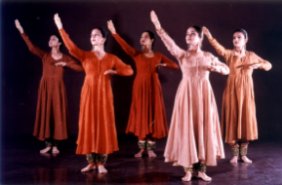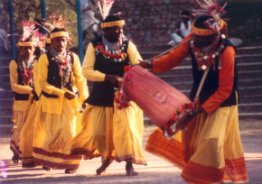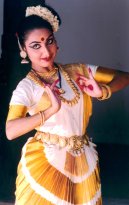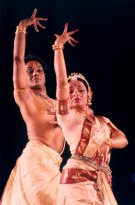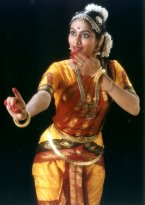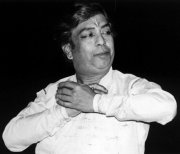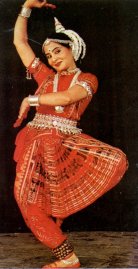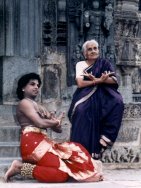| |
 |
 |
  |
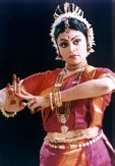 |
|
|
|
|
|
| |
|
INDIA
DANCES |
| |
|
In
a variety of ways. On stage, in the streets, at weddings, for funerals,
fun or fashion. It has |
| |
|
always
danced through the 5000 years of its long and often colorful history .While
its villagers |
| |
|
sway
to the rhythms provided by nature - at harvest or sowing seasons - its urban
folks dance |
| |
|
too to the beat of disco, pop or rock music. What makes it tick? |
| |
|
|
|
| |
|
|
|
| |
|
|
| |
|
|
| |
|
|
| |
|
|
| |
|
|
| |
|
|
| |
|
|
| |
|
|
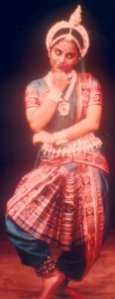 |
|
|
| |
|
|
|
| |
|
For
centuries, the temples were the preserve and the epi-center of all social
activity. The |
| |
|
temples
were patronized by local rulers or important kings and looked after by them.
In |
| |
|
addition
to the priests, a special class of dancers called the deva (god) dasi (servant)
were |
| |
|
dedicated
to the temples. These were women of great learning, scholarship and grooming. |
| |
|
|
| |
|
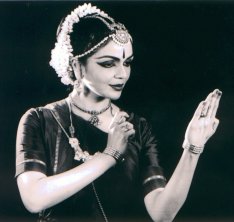 |
| |
|
| |
|
| |
|
| |
|
| |
|
| |
|
| |
|
| |
|
|
| |
|
|
| |
|
|
| |
|
|
|
|
| |
|
|
With
the coming and subsequent domination by colonial powers (16th-20th century),
patronage |
| |
|
|
to
the temples declined and most art forms suffered a slow death. Not exposed
to higher |
| |
|
|
learning,
these foreigners dubbed all dance as Nautch, a derogatory term
often associated with |
| |
|
|
prostitution.
Overnight, these elegant women of great learning
were reduced to Nautch-girls. |
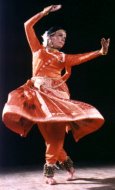 |
|
|
|
| |
|
| True,
the long colonial rule had been preceded by a longer Muslim
or |
|
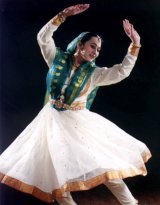 |
| Mughal
rule but that did not alter the indigenous arts.
At best it led |
|
| to
a fusion as manifested in architecture, painting,
and dance forms |
|
| like
Kathak, which partook of court
culture. Most kings encouraged |
|
| poets,
artists, musicians and
dancers in their courts. Why, one |
|
| Muslim
king, the Nawab of
Oudh (present day Lucknow) Wajid Ali |
|
| Shah,
went so far as to
compose poems in honor of the blue-god |
|
| Krishna,
and often dressed
up and danced as one in his court. This |
|
| was
reason enough
and good excuse for General Outram to dismiss |
|
|
him and
annex his kingdom! Satyajit Ray, the great film-maker has |
|
| immortalised
this story in his classic The Chess Players |
|
|
| |
|
| |
|
| |
|
| |
|
| |
|
| |
|
| |
|
| |
|
|
home |
|
|
| prologue |
|
|
(Shatranj
Ke Khilari). |
| welcome |
|
|
|
|
| contents |
|
|
It
must be something in the Indian nature to survive and be resilient! Despite
all the |
| subject
moderators |
|
|
invasions,
onslaughts and upheavals, classical dance-forms survived and within a short |
|
history |
|
|
span,
got revived to its pristine glory. Folk dancers danced all along anyway
without |
| sexuality |
|
|
much
interruption as their dance was not dependent on patronage, royal or colonial. |
| social
landscapes |
|
|
|
|
|
art |
|
|
|
|
| dance |
|
|
|
| literature
|
|
|
|
| music |
|
|
|
| cinema |
|
|
|
|
environment |
|
|
|
|
economics |
|
|
|
|
pot pourri |
|
|
|
| feedback |
|
|
|
| |
|
|
|
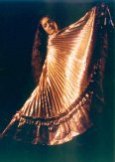 |
|
|
|
|
| |
|
In
the fifty years since independence, lots has happened in the world of Indian
dance. The first |
| |
|
two
decades saw the revival and resurrection of various forms like Orissi and
Mohinattam.
The |
| |
|
next
two decades saw its platforming like never before and the last two
have seen it flowering |
| |
|
and
branching off to interesting arenas and allied arts. Indian dance
has caught the imagination |
| |
|
of
not only the nation but the world. It is indeed amazing
that dance forms lost to
an alien |
| |
|
rule
now rule world cultures! Madonna and Michael
Jackson use it in their songs, composers |
| |
|
and
choreographers create works based
on it. From confusion to fusion and from
nothingness |
| |
|
to
everything The Story of Indian
Dance is as deep as it is deafening. |
| |
|
|
| |
|
|
|
| |
|
|
| |
|
|
| |
|
|
| |
|
|
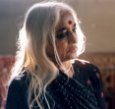 |
|
|
| |
|
| |
|
| |
|
| |
|
| |
|
| |
|
| |
|
|
| |
|
|
|
|
| |
|
|
Who
were these people who helped revive Indian dance forms? What is classical,
ritual, tribal, |
| |
|
|
folk,
martial and modern dance? Who were the stars and who the victims? Who were
the |
| |
|
|
pioneers?
What did they create and how? Where do they stand today? What is contemporary
in |
| |
|
|
a
tradition 2000 years old? |
| |
|
|
|
|
| |
|
|
All
these and more will be platformed here on these pages for you to savor,
see and discuss. |
| |
|
|
India
has always danced, continues to dance and will dance. Join in. Let our dance
begin! |
| |
|
|
|
|
| |
|
|
| Love,
Ashish |
|
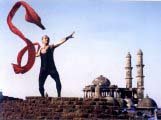 |
| |
|
| |
|
| |
|
|
|
| |
|
|
| |
|
|
| |
|
|
| |
|
|
| |
|
|
| |
|
|
| |
|
|
|
|
| |
|
|
|
Background
Readings |
| |
|
|
|
TOP |
| |
|
|
|
|
| |
|
|
|
|
![]()
![]()
![]()

